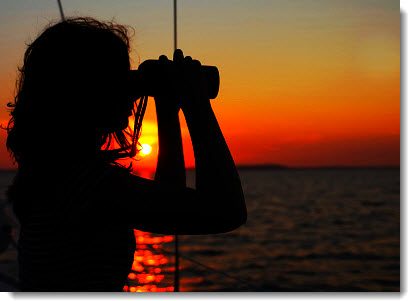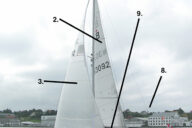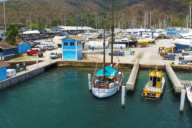Here’s another great set of tips from our friend Capt. John from skippertips.com…
Not many things cause as much tension underway as low visibility. Pea-soup fog, blinding squall, or haze thick as a wool blanket can curl the toes of the saltiest sailor. Follow these seven sea-tested sailing tips for safer, more confident sailing on the waters of the world.

Are you prepared for low visibility sailing. Even in fog-free areas like the Caribbean, squalls can reduce visibility to a few yards or meters. Follow these seven sailing tips for more safer sailing or cruising on the waters of the world.
Navigation and collision avoidance take priority in low visibility. Shorten run distances to aids to navigation in inland waters. Sail courses between aids that are closer to one another. Scan your chart for buoys or lights with a bell, whistle, gong or horn. Make sound equipped aids primary targets if safe and practicable to do so.
Take care not to blindly place a buoy position as a waypoint into the GPS. Aids may be positioned on the edge of a shoal. Give yourself a wide berth or increase your GPS waypoint proximity circle radius. Set the GPS to alarm when you touch the perimeter of the circle.
If in doubt of your position, anchor or stop the boat. If you run out your estimated time to the next aid and it does not appear, stop and listen. Sounds are sharper in fog and you may be able to hear sound, in particular in a chop (many sounds are activated by wave action). Get oriented before you proceed. Now, let’s take a look at seven other tips to get you home safe ‘n sound.
1. Wear Flotation with Gear Attached.
Make sure that all hands put on inflatable vests or life-jackets. Fasten all straps and snaps. In recent years, overboard incidents that involved loss of life showed one little-known “Achilles’s heel” of the inflatable pfd–lack of crotch-straps! Without crotch-straps, the pfd will tend to float up over the head. Install crotch-straps on any type of pfd to keep flotation in place.
Attach flashlights and police-type whistles to each vest or life-jacket. Stuff a wool or microfiber watch cap in your pocket. If you go into the water, this will help slow down the onset of hypothermia.
2. Energize Navigation Lights.
The navigation rules require all vessels to show proper lights during darkness or reduced visibility — day or night. Sailboats show red and green side lights and a white stern light. If you have your engine on, turn on your masthead light. See “Related Articles” links below for other lights you might see in low visibility or at night.
3. Warn Others of Your Location and Status.
Use a manual fog horn or air canister horn to warn other vessels of your position and actions. Sound fog signals in or nearareas of low visibility. Why do the navigation rules require you to sound signals “near” a low visibility area? Here’s an example…
In San Francisco Bay, fog banks can shroud one part of the bay while it’s crystal clear on the other side. If you’re sailing near a fog bank you will need to sound fog signals to warn vessels inside the bank of your position.
Vessels under sail sound one prolonged blast (4-6 seconds) followed by two short blasts (a short blast lasts about one second), every two minutes. If under power, sound one prolonged blast every two minutes. If under power but drifting, sound two prolonged blasts every two minutes. Also, see the “Related Articles” links below.
Assume that other vessels do not know or choose not to comply with the Navigation Rules. They may not turn on navigation lights in low visibility. Or, they may not sound signals to warn others of their position. Electronics are not a replacement for lights or signals.
Sail with a defensive mindset. Keep clear of shipping lanes or heavy traffic areas. If necessary heave-to or anchor until visibility improves. The small amount of time lost pales when compared to the damage or injury that might occur in a collision or grounding.
4. Maintain a Lookout by “All Means”.
Send one crew forward to the bow away from the noise of the engine. Hearing becomes the most important of your senses in fog or haze. If you hear or sight another vessel, slow down or stop. Figure out what the other vessel is doing before you proceed.
I believe the binocular represents one of the most useful navigation tools aboard–if not the most. Use a high quality, nitrogen sealed (this means watertight–make sure the specs say this–not water resistant!) 7 X 50 binocular to scan in small segments about the same size as the field of view.
Look just above and below the field of view. Then look just to the right and left of the field of view. This technique will often help you pick up the silhouette of an unlighted buoy, a partially submerged obstruction, or another vessel in thick haze or fog.
If you have installed radar and AIS, the navigation rules require that you use it along with visual scanning. Realize that International law requires that you use all means available to avoid collision. Gain peace of mind when you put this defensive action into play.
5. Hoist Radar Reflectors.
Purchase two radar reflectors. The best designs have three round panels that bisect one another at 90 degree angles. Hoist the reflector so that the top panels form a “V”. This presents the best reflective surface when heeled over. Hoist the reflectors high up on your backstay and shrouds. Also, see the “Related Articles” link below.
Keep a powerful, one million candlepower, handheld spotlight in the cockpit. If a ship approaches, shine the light onto your sails and in the direction of the vessel.
6. Stop, Listen and Look!
Heave to often, stop the boat and listen. If under power, stop the engine and listen for several minutes. To find a sound equipped navigation buoy (bell, whistle, gong), make a tight circle to create a wake. Then, stop the boat and listen.
7. Prepare Your Anchors for Instant Use.
Carry at least 300 feet of anchor rode (line) and two anchors. Make sure you can get your anchor over the side in a few seconds. If unsure of your position, anchor until you sort things out. If underway and you hear surf (breakers) ahead, turn and head toward safe water. If unable to start the engine or make way under sail, lower the anchor right away with maximum scope.











